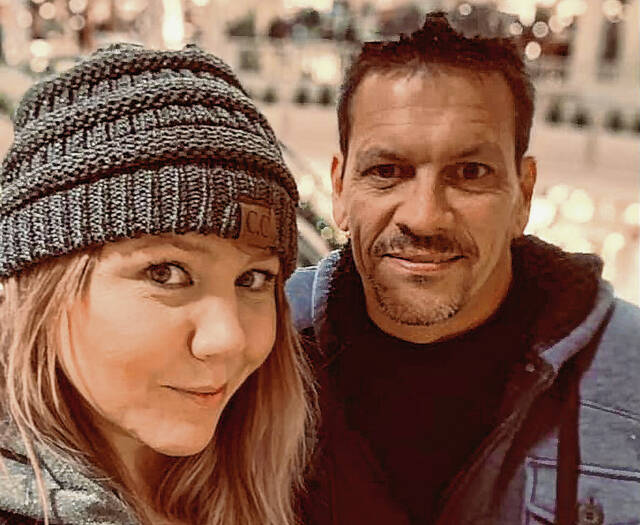
Photo provided Hope resident Tim Stewart is shown with his fiance Melissa Wagers in a photo taken before he contracted COVID-19.
Tim Stewart knew something was wrong.
It was a couple days after Christmas and the 53-year-old Hope resident and father of five was helping his son with his truck in the family’s barn when he suddenly started feeling tired and “run down.”
Stewart described himself as an “extremely active” person with the energy of a 25-year-old, working at Caterpillar in Franklin while also holding side jobs as a truck driver and helping his son with a mowing business.
But something just felt odd about the fatigue he was experiencing, he said.
“I just noticed I was getting really tired, and that’s not normal for me,” Stewart told The Republic. “…And I thought, ‘Something’s not right.’”
What Stewart didn’t know was that he would soon be hospitalized for the first time in his life as he struggled to fend off COVID-19 — a virus he had downplayed and thought he would never get.
At times, Stewart said his battle felt like “the Grim Reaper was sitting there, and you were touching his feet.” And it’s a battle he’s still recovering from weeks later.
But as the waves of fatigue just kept coming in late December, COVID-19 was the last thing on Stewart’s mind.
‘Strange’ headaches
Before long, Stewart started experiencing what he described as “strange” headaches that would not go away — not even after taking Tylenol or Aleve. At about the same time, he started feeling nauseous and lost his appetite.
Stewart’s fiancé, Melissa Wagers, said she thought that he should get tested for COVID-19. Melissa had survived her bout with the virus last year and had some home tests.
But Stewart refused.
“I was like, ‘I don’t want to take one of those. I’m not doing that crap,’” Stewart said.
“I’m not going to get (the virus.),” Stewart recalled thinking at the time. “I’ve got too good of an immune system. …(COVID-19) is nothing more than a bad case of the flu.”
Stewart wasn’t vaccinated either, describing himself as “very against the vaccine” at the time because of how fast the shots were developed and uncertainty over their ingredients.
Eventually, Stewart relented and agreed to get tested. A home test came back positive but his fiancé called around to find a place to repeat the test. But finding a testing site proved more difficult than he had imagined, and they wound up driving to Greensburg.
When Stewart got to the testing site, “I remember the lady telling me, ‘I’ve got 76 to test today.’”
“That’s when it just kind of starts sinking in,” Stewart said. “…Wow, maybe this is real.”
“Keep your fingers crossed,” the lady told Stewart as she processed the test. “I haven’t had anybody positive yet today.” But 10 minutes later, she returned with some startling news: “You’re positive.”
“I was like, ‘oh no,’” Stewart said.
Stewart went home and quarantined in an upstairs bedroom.
After a couple days, the headaches vanished. “I woke up, and they were just gone,” Stewart said. “I started to feel fine.”
He was still experiencing fatigue and loss of appetite, but he thought he might be rounding the corner. However, his battle with COVID-19 was just beginning.
‘Going downhill’
The fever started on New Year’s Eve and quickly reached 102.9 degrees.
Medication would help bring his temperature down a little bit. But once it wore off, his fever would come roaring back.
On Jan. 3, Stewart’s fiancé called his doctor and set up a virtual appointment for later that day. The doctor recommended some medication but said, “if you get any worse, you probably need to go the ER.”
Stewart had an oximeter at home and was advised to keep a close eye on his blood oxygen saturation level — a measure of how much oxygen in the blood.
Normally, a healthy person would be expected to have a blood oxygen saturation level of 95% to 100%, according to the Centers for Disease Control and Prevention. Stewart was told that if his level dropped to 93% of 94%, he needed to go to the hospital right away.
His fatigue continued to get worse until Stewart said he was “sleeping 23 (hours) out of the 24-hour day.” And everything started to hurt.
“I could not stay awake for nothing,” Stewart said. “My body was just aching real bad. My joints were aching real bad.”
Before long, he was having difficulty breathing, and his blood oxygen saturation levels had started to fall.
‘Dragging you to death’
At about midnight on Jan. 5, Stewart’s fiancé went upstairs to check on him.
“My oxygen levels were getting down to about 89%,” Stewart said. “She’s asked me what I wanted to do, and I could barely respond to her.”
“We’ve got to go” to the hospital, Stewart eventually managed to say.
Melissa drove him to Columbus Regional Hospital. But even after the drive to the hospital, Stewart was still “just completely wiped out” from walking down one flight of stairs and out to their car.
When they arrived at CRH, Stewart tried to get out of the car but couldn’t muster the strength, he said. CRH medical staff had to come outside and carry him from the car into the emergency room “because I didn’t have enough strength get out of the car.”
By then, his blood oxygen saturation level had fallen to the mid-80s. Stewart was scared. Melissa “was extremely scared.”
“I didn’t know what was going on,” Stewart said. “I mean, it was almost like I was slipping out into a coma. I could see things going on, but I couldn’t stay awake long enough to do anything.”
“It felt like the Grim Reaper was sitting there, and you were touching his feet,” Stewart added. “…It felt like it was literally just dragging you to death at that point. You’re dehydrated, you’re just losing all your sense of function pretty much. You don’t know what’s going on. You just can’t comprehend anything at that point. …It’s like your body’s slipping away from you.”
But Stewart wasn’t alone. He was one of dozens of people at CRH who were hospitalized with COVID-19, according to hospital records. Staff were hurriedly putting beds in the waiting room and along some hallways to accommodate the surge in patients.
At one point last month, there were 70 people hospitalized with COVID-19 at CRH.
Stewart shared a room a with a man he thought was in his 70s who was also battling a COVID-19 infection. Eventually, the man’s health deteriorated, and he was taken to the intensive care unit.
“I don’t know if he ever made it out of the ICU or not,” Stewart said.
The hospital staff tried to stabilize Stewart and monitored him through the night. Eventually, his fever started to subside with the help of some medication.
A doctor came into his room “in a full biohazard suit” with a “little oxygen pack that pumping oxygen inside the suit,” Stewart said. It looked as if the doctor was “an astronaut going to space.”
The doctor asked Stewart if he was vaccinated against COVID-19. Stewart said, “I’m completely against that.”
The doctor started Stewart on an experimental intravenous medication called Remdesivir that federal regulators had authorized for emergency use to treat COVID-19.
But before the doctor left, he turned to Stewart and said, “We’ve had people come in that are younger than you, and they haven’t made it. They didn’t make it out of the ICU.”
‘Baby steps’
Stewart would spend three days in the hospital.
He was responding well to the Remdesivir — his fever had gone away, his blood oxygen levels were rising and his appetite had started to come back.
But while he was laying there, Stewart’s views on the vaccine started to change, he said.
He said he could hear people in adjacent room coughing to the point they had started gagging. Other patients were experiencing “brain fog” and would yell things that didn’t make sense. Then he found out that there were patients waiting to go the ICU because no beds were available.
“That’s where the sense of reality really set in,” Stewart said. “Wow, this is bad. This is really bad.”
“Everybody that came in for me, I specifically asked them, ‘What do you think about this vaccine?’ And they everyone of them said, ‘I would definitely get it. …You got lucky that you got through this one,’” Stewart said.
Stewart said he will get vaccinated the “first chance I get” because “I don’t want to go through this again because I don’t know if I’ll make it through a second round of this or not.”
Stewart ended up getting released from the hospital a few days early, but he was still far from his normal self. And doctors expect that it may take months for him to fully recover.
About three days after being released, Stewart started experiencing tremors. “If I did anything other than lay still, I’d just shake really bad,” he said.
The tremors have since gone away, but Stewart’s joints still hurt and is still being bogged down by fatigue. Stewart recently went back to work at Caterpillar but had to quit his two side jobs because he doesn’t have the energy he used to.
“I don’t have any energy,” Stewart said. “I don’t have near the energy that I had. I go home and take a shower and eat something, and I lay on the couch. I’m usually out in less than five minutes on the couch.
“I’ve been told it’s going to take some months to get through this,” Stewart added. “And some people, I guess, have had it way longer than that. …Every day is baby steps.”
Now, Stewart is a staunch advocate for the vaccines and blames social media for spreading misinformation and scaring people from getting potentially life-saving shots.
“I’ve been through this, I’ve experienced this, and you don’t want it,” Stewart said. “…I’d say, ‘Get that vaccine’ because if you have to go through the full-blown symptoms like I did, you’ll change your mind really quick. You won’t worry about what’s in that vaccine. You’ll just want it because it scares you enough, it brings you close enough to the reality that, ‘Hey, I may not make it through this. I may die from this.’”




